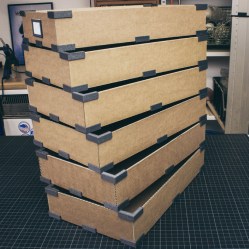It’s not that storage boxes and organizers are hard to find. No, the problem this project set out to solve was more nuanced than that. The real trouble [theguymasamato] had was that his storage options — wide shelves and deep drawers — weren’t well suited to storing a lot of small and light objects. The result was a lot of wasted space and poor organization. To make matters worse, his big drawers had oddball dimensions, meaning that store bought organizers weren’t a good fit either.
 To solve these problems, [theguymasamato] decided to design his own stackable boxes to store small and light objects far more efficiently than before. The design also allows the boxes to be made in a variety of sizes without changing any of the 3D printed parts. Carefully measured and cut cardboard is critical, but that’s nothing a utility knife and ruler can’t solve. The only other requirements are a few simple plastic parts, and some glue. He can fit six of these inside a single one of his drawers with enough room to access and handle them, but without wasting space.
To solve these problems, [theguymasamato] decided to design his own stackable boxes to store small and light objects far more efficiently than before. The design also allows the boxes to be made in a variety of sizes without changing any of the 3D printed parts. Carefully measured and cut cardboard is critical, but that’s nothing a utility knife and ruler can’t solve. The only other requirements are a few simple plastic parts, and some glue. He can fit six of these inside a single one of his drawers with enough room to access and handle them, but without wasting space.
Cardboard is really versatile stuff. Not only has it been behind some amazingly complex devices such as this tiny working plotter, but we’ve seen it form major components in the remarkably ambitious cardboard CNC.
















Very interesting concept.
Yeah, I’d buy a bag of the plastic bits if they were for sale. (I don’t have a 3D printer.)
Is the 3d printed part in thingiverse?
Not that I see, but the STL files can be downloaded from near the bottom of the project’s page (step 8).
I repeat today again.True so do not need a 3D printer. Only knife,scissors and stapler. Naturally empty tetrapacks and a bit of sticky tape. https://www.instructables.com/id/Simple-Organizer-of-Tetrapack-Storage/
a couple of observations…
1. Tetrapacks aren’t as common in the US
2. Your project looks like it was made from garbage
1.In Germany, quite a lot of products in tetrapacks
2. Indeed, this is rubbish. Not very nice? It is more convenient for me in the workshop to store them in separate boxes, than it is in one big pile, where it is very difficult to find something.
Shame about the aesthetics, but re-using TetraPaks is brilliant since they’re an environmental nightmare.
Non-coated paper products are hygroscopic. Conversely, some cardboard and paper and their respective coatings tend to exacerbate ESD (net positive charge).
Some plastics (typically PVC, PET, and styrene) can generate and retain very large charges (net negative charge) such that anti-ESD foam is required at bottom of each storage section. Some plastics will react with steel coatings and polyimides and other stuff.
Wood tends towards a net neutral charge (but some processed stuff is not neutral).
Pure and uncoated aluminum can, theoretically, have a slight net positive charge, but most Al stock is coated with stuff that is neutral. And most Al alloys are relatively nonreactive with Plastics and most adhesives.
My conclusion. Long-term and medium-term storage for electrical components not sealed in original factory packing should probably be stored in plastic bins specifically formulated for electronic stuff, or should use aluminum and/or unprocessed wood.
I use the same idea to create project cases using double-sided printed circuit board. Works well.
Why use the 3d printed parts to make paper boxes? You can already make boxes purely using cardboard…
1. corners protect from wear
2. corners can be bought in a hw store for dime a dozen, but owning a 3d printer seriously warps one’s mind
3. As long as it’s not claiming to save world pollution, global warming, hunger, making world a better place and has no kickstarter, it’s just someone trying to tidy up their place. Good for them.
It’s not much harder to fold cardboard without 3d printed parts and the folded boxes will be stronger.
Heap them but make a robot pick them out. Then have another robot gobsmack the first one with Dwarven bins covered in cut stones, art, and decorated with bone.